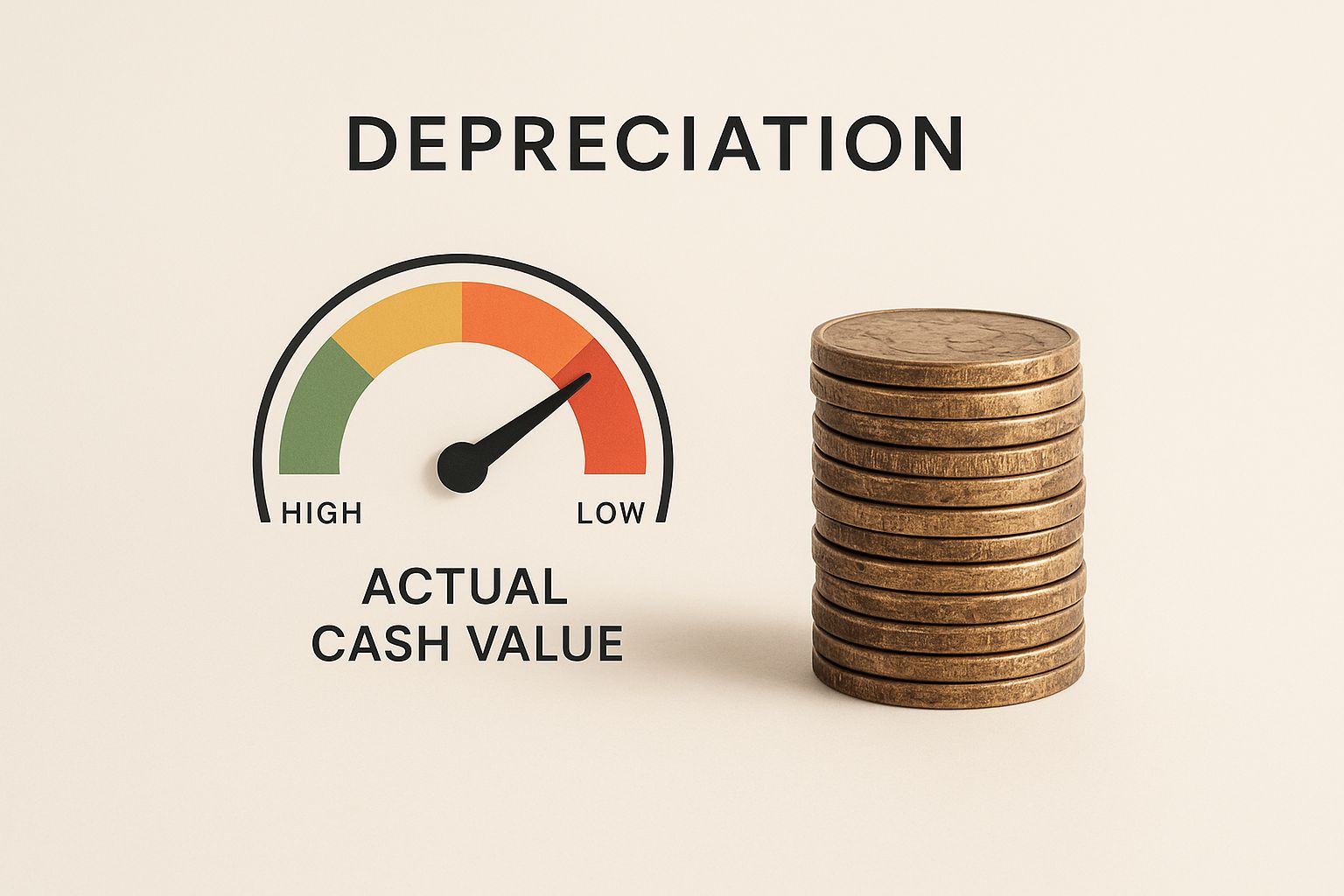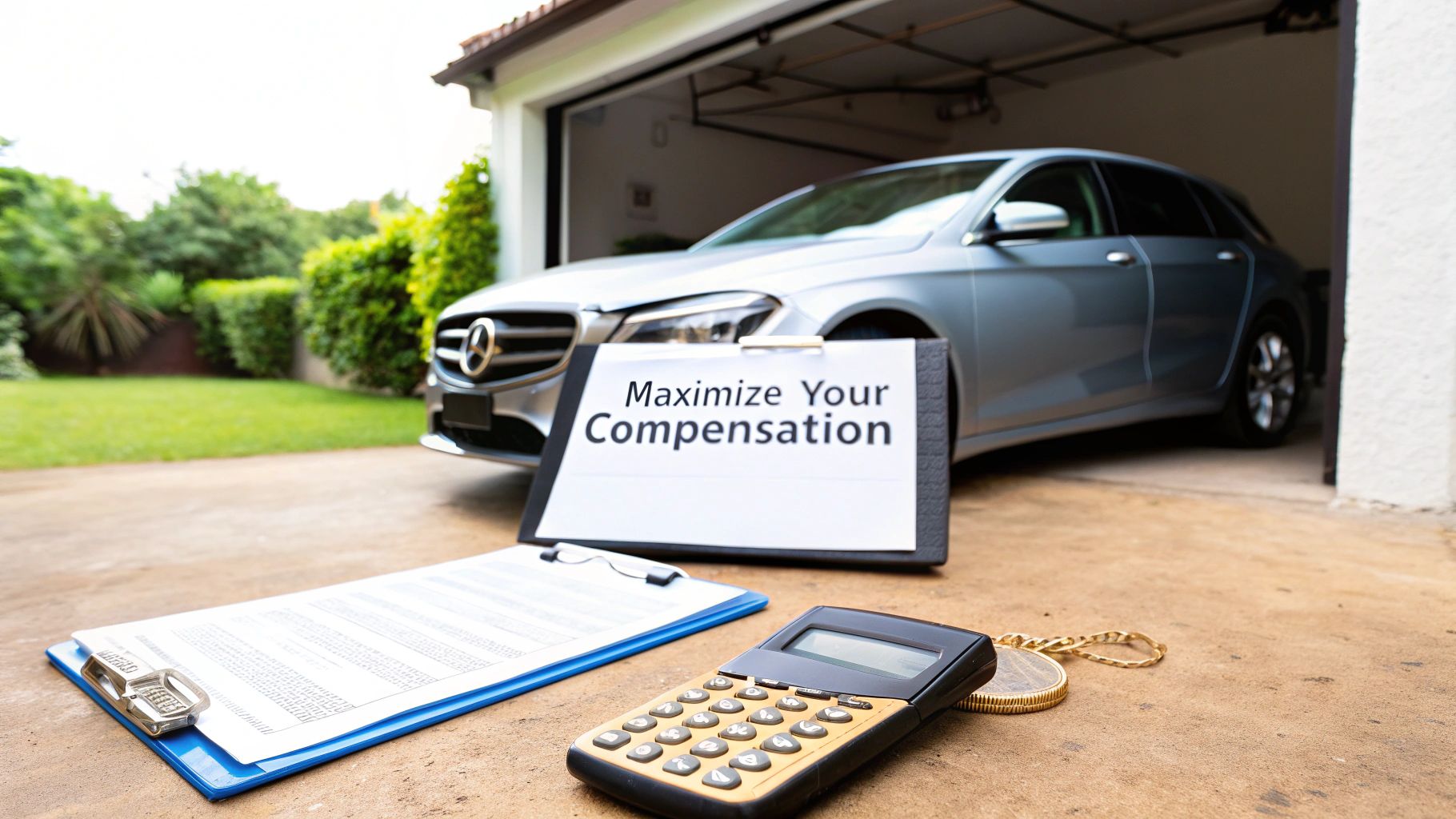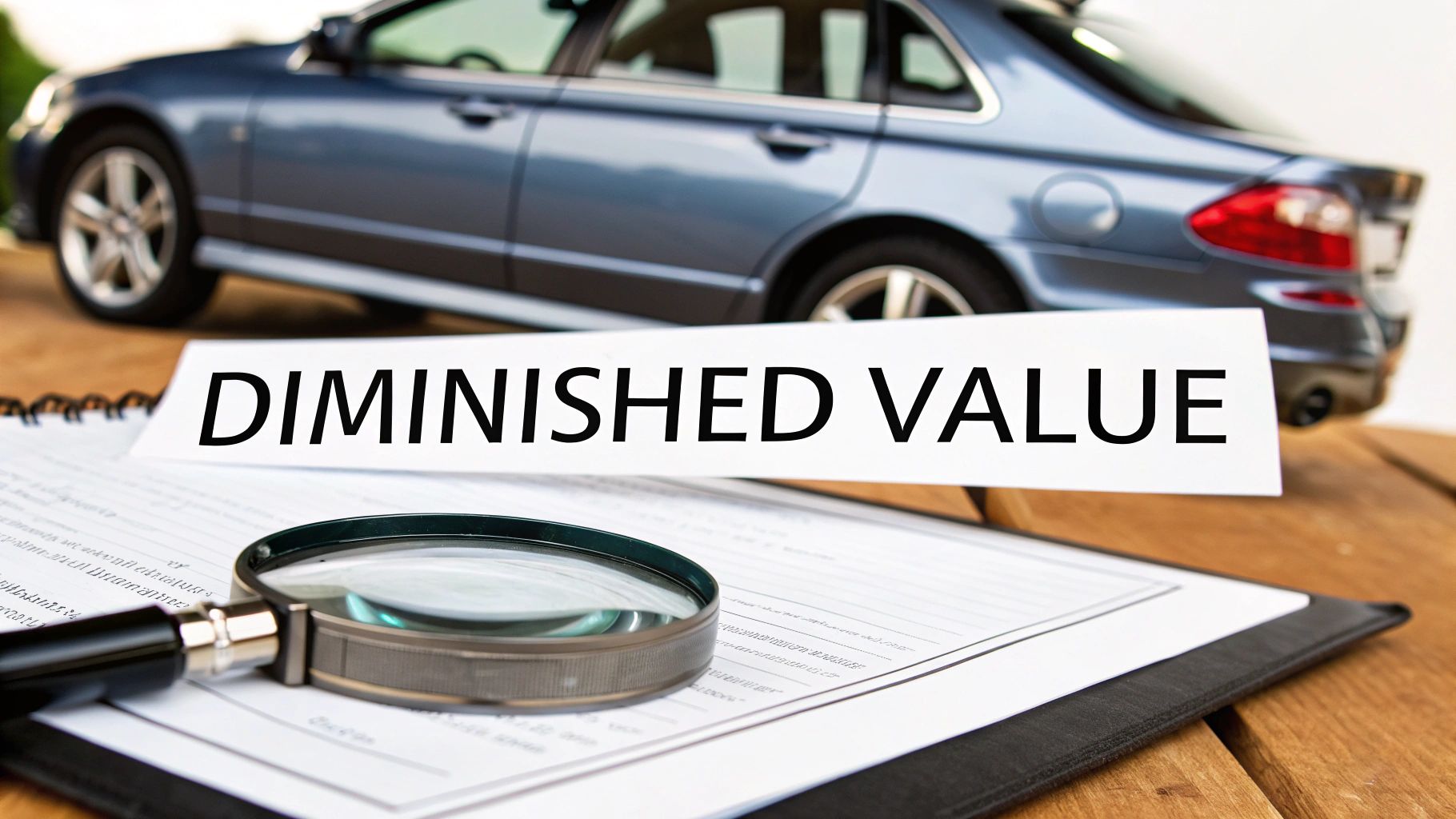When you're dealing with an insurance claim, especially for a total loss, two terms get thrown around that sound similar but mean very different things: actual cash value and market value. Getting them straight is the first step to understanding your settlement check.
The simplest way to think about it is this: Actual Cash Value (ACV) is an insurance formula. It's what your property is worth to the insurance company today, which means its original cost minus all the wear and tear it's accumulated. On the other hand, Market Value is a real-world number—it's what a willing buyer would pay for that same item on the open market.
Why This Difference Matters For Your Payout
When your car is totaled or your roof is destroyed, the valuation method used by the insurer directly impacts how much money you'll receive. These two concepts, ACV and market value, can lead to surprisingly different figures because they measure value from completely different perspectives.
This image really drives home how depreciation is the key factor that shrinks your payout under an ACV policy.

As you can see, the older an item gets and the more it's used, the wider the gap becomes between what you originally paid and what the insurance company will pay you.
What Really Separates ACV and Market Value?
The biggest sticking point is depreciation. With an ACV calculation, depreciation is a mathematical deduction. The insurer takes the item's age and expected lifespan and subtracts value for every year of use.
Market value, however, doesn't work like that. It’s all about supply and demand. The condition of your item certainly plays a role, but so do things like location, current trends, and even how desirable it is to potential buyers. A vintage car, for instance, might have a market value far higher than its depreciated ACV because it's rare and sought-after.
Understanding what makes the market tick is crucial. You can find some great tips for finding the best market price for your vehicle that show just how many factors influence that final sale price.
To quickly see how these two terms stack up, here’s a simple breakdown.
ACV vs Market Value At a Glance
| Characteristic | Actual Cash Value (ACV) | Market Value |
|---|---|---|
| Primary Use | Calculating insurance claim payouts. | Determining a sale price in an open market. |
| Depreciation | A core component; value is deducted based on a formula. | Not a direct deduction; condition is just one factor affecting price. |
| Key Factors | Original cost, age, and estimated useful lifespan. | Supply, demand, location, and buyer perception. |
| Typical Payout | Almost always lower than the original cost or replacement cost. | Can be higher or lower than the original cost. |
This table makes it clear that while both are measures of "value," they serve very different purposes and are influenced by completely different forces.
Let’s put this into perspective with a common scenario. Imagine a two-year-old laptop you bought for $1,000. The insurance company might calculate its ACV at just $600 after factoring in two years of depreciation. However, you might find that its market value—what someone would actually pay for it on a site like Facebook Marketplace—is closer to $700 because it’s a popular model.
This gap is at the heart of the actual cash value vs market value conversation. Insurers stick to their formulas, but you live in the real world where market forces rule. To get a better handle on how appraisers figure this out, it’s worth reading up on https://totallossnw.com/what-is-fair-market-value/.
How Insurers Actually Calculate These Values

When you file a total loss claim, the valuation process can feel like a black box. But insurers and appraisers aren't just guessing; they're using specific methods to determine what your property was worth. Peeking behind the curtain to see how they arrive at these numbers is crucial if you want to understand—and fairly negotiate—your settlement.
For an insurance company, calculating the Actual Cash Value (ACV) is a standardized process rooted in a specific formula. It’s designed to be consistent and defendable according to the language in your policy.
ACV = Replacement Cost – Depreciation
While the formula looks simple, the real devil is in the details of "depreciation." This is where an adjuster factors in your property's age, its typical lifespan, and its condition right before the loss. A well-maintained, five-year-old vehicle will have a much lower depreciation deduction than one of the same age with high mileage and visible wear. For a closer look at the math, you can check out our detailed guide on the actual cash value formula.
How Market Value Is Determined
Figuring out Market Value, on the other hand, is less about an internal formula and more about a real-world investigation. The appraiser's job is to pinpoint the price a willing buyer would realistically pay for your property on the open market at the time of the loss.
This process involves a few key steps:
- Comparable Sales (Comps): Appraisers hunt for recent sales of nearly identical items in your local area. For a car, this means finding the same make, model, year, and trim package.
- Condition Analysis: The specific condition of your property is put under a microscope. This covers everything from the mileage and service history of a car to the wear and tear on personal belongings.
- Market Trends: What’s the current demand for this item? A rare, classic car might be appreciating in value, while a mass-market sedan is almost guaranteed to lose value over time. These supply-and-demand dynamics directly impact the final market value.
The Wild Card: Legal Precedent
The whole actual cash value vs. market value discussion gets even more complicated when the law gets involved. Many policyholders don't realize that the exact method for calculating ACV isn't the same everywhere—it can change quite a bit from one state to another.
Some states follow what’s known as the "broad evidence rule," which came out of landmark court cases like McAnarney v. Newark Fire Ins. Co. This legal standard allows adjusters and courts to look at all relevant evidence of value. So, instead of just using the simple replacement-cost-minus-depreciation formula, they can also consider market value, obsolescence, and even the property's income-generating potential. This flexibility can sometimes result in a fairer valuation, but it can also create more room for disagreement. It’s a key reason why the ACV on your settlement offer might not line up with a straightforward calculation.
What This Means for Homeowners Insurance Claims

When disaster strikes your home, the difference between actual cash value vs market value suddenly becomes very real. This is a common point of confusion—and potential financial hardship—for property owners. The heart of the matter is that your home's market value, which is the price a buyer would pay for it, is almost never the same as its insurance value.
Insurers don’t cover the intangible things that drive up your property's sale price. Think about what makes a home so desirable: a fantastic location, being zoned for a top-rated school district, or having immaculate, mature landscaping. While these elements can dramatically boost market value, they are irrelevant when it comes to the cost of physically rebuilding your house after a fire.
Your insurance policy is there to cover the structure itself, not the plot of land it sits on or the appeal of its location.
The Problem with Insuring at Market Value
Many homeowners fall into the trap of thinking they should insure their home for its market price. This mistake can swing one of two ways, both of them bad: you either pay way too much for coverage you don't need, or you end up drastically underinsured when you need the money most.
Let's break it down. The market value is what your home could fetch in the current housing market—a figure swayed by location, lot size, and local trends. In a hot real estate market, a house might have a market value of $700,000, but the actual cost to rebuild the physical structure could be just $350,000. If you insure it for the full $700,000, you're paying inflated premiums to cover the value of the land, which isn't at risk of burning down. For a deeper dive into how these valuations shape your policy, you can learn about the different insurance valuations from Matic.
Key Takeaway: Insuring a home based on its market value is a common and costly mistake. Insurance is for rebuilding the structure, not for replacing the land or the neighborhood’s desirability.
On the flip side, if the housing market takes a nosedive, your home's market value could plummet below its rebuilding cost, leaving you dangerously underinsured.
A Tale of Two Policies: A Practical Scenario
Imagine two homeowners. Both of their homes would cost $400,000 to rebuild from scratch after being completely destroyed.
- Homeowner A insures their house based on its high market value of $600,000. They pay steep premiums for coverage they can never fully access, since the policy will only ever pay to reconstruct the building itself, which costs far less.
- Homeowner B has an Actual Cash Value (ACV) policy. After a fire, the insurer agrees the rebuilding cost is $400,000. However, they then subtract $100,000 for depreciation on the 20-year-old roof, siding, and fixtures. Homeowner B gets a check for $300,000, leaving them to find another $100,000 out of pocket to complete the rebuild.
This scenario really brings the trade-offs into focus. Over-insuring based on market value is a waste of money on premiums. But settling for an ACV policy can create a massive financial gap when you file a claim. The sweet spot is getting coverage based on your home's replacement cost, not its sale price.
How Valuations Impact Your Total Loss Payout
When it comes to a totaled car, the whole debate over actual cash value vs market value gets a lot simpler than it does with real estate. In the auto insurance world, they’re practically the same thing. Your car's Actual Cash Value (ACV) is its fair market value right before the crash happened.
Think about it: a house's value is tied to the land, the neighborhood, the schools. A car's value is almost entirely about the car itself. The insurance company's job is to figure out what your specific vehicle—with its exact year, make, model, mileage, and overall condition—would have fetched on the open market in your area. They're not just plugging numbers into a depreciation calculator; they're doing market research.
This means your final payout is directly linked to what similar cars are currently selling for. If you drove a popular model known for its reliability and strong resale value, your ACV will be higher. On the other hand, if your car was an older model with a lot of miles on the clock, its ACV will reflect that lower demand.
How to Get a Fair Payout for Your Totaled Car
Because your car’s ACV is based on its pre-accident market value, the first offer you get from an adjuster isn’t set in stone. It's a starting point, an opening bid based on data from third-party companies that track local vehicle sales. You absolutely have the right to push back on a low offer, but you need to come prepared with good evidence.
This is where your own records become your greatest asset. Every dollar you invested in maintaining or improving your vehicle can directly bump up its market value, and by extension, its ACV.
An insurer's initial total loss offer is a starting point for negotiation, not the final word. Your own detailed records are the key to proving your vehicle’s true pre-accident worth and getting the settlement you deserve.
If you want to successfully challenge a low valuation, you have to prove your car was worth more than their number. You can’t just say it was in great shape; you have to show it.
Documentation You Need to Maximize Your Settlement:
- Recent Upgrades: Did you buy new tires a few months ago? Install a better stereo? Keep those receipts. They prove you invested in the vehicle.
- Maintenance Records: A complete service history from your mechanic shows the car was well-cared-for, which justifies a higher value than a comparable car with a questionable past.
- Custom Features: If you added any aftermarket parts, from a new exhaust to custom rims, have the receipts and photos ready to document their value.
- Pre-Accident Photos: A picture is worth a thousand words. Clear photos showing your car was pristine before the accident are incredibly persuasive.
When you present this kind of information, you change the entire conversation. It’s no longer about the value of a generic 2018 sedan; it’s about the value of your specific, well-maintained 2018 sedan. Being proactive is the best way to make sure the final check truly covers the market value of what you lost.
A Better Option: Replacement Cost Value Coverage
So far, we've focused on the difference between actual cash value and market value. But there's a third, much more powerful option every property owner should seriously consider: Replacement Cost Value (RCV). Think of it as the ultimate "make you whole again" coverage, designed to help you recover from a loss without the financial gut punch of depreciation.
Unlike an ACV policy, which pays you what your damaged property was worth the second before it was destroyed, an RCV policy gives you the money to buy a brand-new, similar item at today's market price. If a fire destroys your five-year-old laptop, RCV coverage pays for a comparable new one, not just the couple hundred bucks your old one was worth. This completely closes the gap that ACV policies leave, meaning you can rebuild or replace without draining your savings account.
How RCV Policies Actually Pay Out
This is where things can get a little confusing if you're not expecting it. Most insurance companies handle RCV claims with a two-payment process. Knowing how this works ahead of time is critical to getting every dollar you're entitled to.
Here’s the breakdown:
- Payment #1: The insurer first calculates the Actual Cash Value (ACV) of your damaged item and sends you a check for that amount. This initial payment is meant to get the ball rolling on repairs or replacements.
- Payment #2: Once you've actually bought the new item or finished the repairs, you send the receipts to your insurer. They will then release the second and final payment, which covers the depreciation amount they initially held back.
Key Insight: To get the full replacement value, you must actually replace the item. RCV policies are built to cover the real-world cost of replacing what you lost, so you need to provide proof of purchase before the insurance company will release the remaining funds.
The Trade-Off for Superior Protection
Of course, this higher level of protection isn't free. RCV policies come with higher premiums than their ACV counterparts, simply because the potential payout from the insurer is much larger. Deciding which one is right for you boils down to your personal finances and how much risk you're willing to take on yourself.
An ACV policy saves you money on your monthly premiums, but it forces you to shoulder the cost of depreciation when you file a claim. An RCV policy, on the other hand, costs more upfront but delivers the peace of mind that a major loss won't leave you with a crippling out-of-pocket expense. For most homeowners, paying a little more for RCV coverage is a smart investment to avoid a financial disaster down the road.
Strategies to Secure a Fair Insurance Settlement
When you're dealing with a major property loss, what you do before and after the incident can make or break your final settlement. The key is to be proactive. Your goal is to build such a strong, undeniable case for your property's value that the insurance adjuster has no choice but to offer a fair amount.
Honestly, the single most powerful thing you can do happens before you ever have to file a claim: create a detailed home inventory. I'm talking about cataloging everything you own with photos, videos, serial numbers, and receipts if you have them. This documentation takes your claim from a vague estimate to a concrete reality of proven ownership and value.
Once a loss occurs, that same level of meticulous record-keeping is absolutely critical.
Documenting Your Claim Effectively
After you've made sure everyone is safe, your very first job is to document the damage. And I mean extensively. Take hundreds of photos and videos from every possible angle. Get wide shots of the overall scene and then zoom in on the specific details. This visual proof is the foundation of your entire claim.
Next, you need to start a claim diary. Log every single phone call, email, and conversation you have with your insurance company. Make sure to note:
- The date and time of the interaction.
- The name and title of the person you dealt with.
- A detailed summary of what you talked about.
This log creates a paper trail that keeps everyone honest and prevents "misunderstandings." Without it, crucial verbal agreements can easily be forgotten or flat-out denied later on.
Crucial Tip: Never, ever rely on verbal promises from an adjuster. If they agree to something important over the phone, send a follow-up email immediately confirming the conversation. This gives you a written record to point back to.
Knowing your policy inside and out is non-negotiable. You have to find the "Valuation" or "Loss Settlement" section and understand if you have an Actual Cash Value (ACV) or a Replacement Cost Value (RCV) policy. This detail is central to the entire actual cash value vs market value calculation and determines how your payout is figured. For a more detailed breakdown of the back-and-forth, our guide on how to negotiate a total loss settlement walks you through the steps.
When to Bring in Professional Help
Sometimes, no matter how well you prepare, you'll hit a wall. If the settlement offer is just plain wrong and the adjuster refuses to negotiate in good faith, it’s time to think about calling in reinforcements. This is the point where hiring a professional can completely change the outcome.
A public adjuster is an expert who works directly for you, not the insurance company. They'll take over the entire claims process—from documentation to negotiation—in exchange for a percentage of the final settlement. If the main point of contention is the value of your property, you can also invoke the appraisal clause in your policy. This involves hiring an independent appraiser to fight for a fair resolution. These pros level the playing field, making sure your claim is valued based on real data, not just the insurer's cost-saving software.
Common Questions About Insurance Valuation
Going through an insurance claim can feel like you're learning a new language, and it's natural to have questions. Now that we've unpacked the tricky concepts of actual cash value vs. market value, let's tackle some of the most frequent questions people have.
Can I Dispute the Insurance Company's ACV Offer?
Absolutely. If the insurance company's ACV offer feels low, you not only can dispute it—you probably should. Your first move is to ask for a copy of the adjuster's valuation report. This is the document that breaks down exactly how they arrived at their number, including the specific comparable items they used as a benchmark.
Once you have that report in hand, it's time to build your case. Gather your own evidence to counter their assessment. This could include:
- Receipts for any significant upgrades or recent major repairs.
- Plenty of clear photos that showcase the fantastic pre-loss condition of your property.
- Your own research on comparable vehicles or items currently for sale in your local area that justify a higher valuation.
If you and the adjuster can't see eye-to-eye, don't give up. Your policy likely includes an appraisal clause. Invoking this clause is a powerful step that brings in an independent, third-party appraiser to help establish a fair and unbiased value.
Is Market Value Ever Used for Homeowners Insurance?
For the most part, no. Homeowners insurance is built to cover the cost of rebuilding your house (replacement cost) or its value after depreciation (ACV)—not what it would sell for on the real estate market. Why the distinction? Because market value bundles in the price of the land, which isn't going to be destroyed by a fire or a tornado.
Relying on market value for home insurance is a gamble. You could end up dangerously underinsured if local construction costs are high, or you might overpay for coverage you can't even use.
Why Is My Car's ACV Settlement Less Than My Loan Balance?
This is an incredibly common and painful scenario. The problem is that your car's value (ACV) drops like a rock, especially in the first few years of ownership, while your loan balance decreases much more slowly. This often creates a financial "gap" between what the insurance company pays you and what you still owe the bank.
This is exactly why Guaranteed Asset Protection (GAP) insurance was created. You can typically purchase it from the dealership or your insurer when you first buy the car. If your car is totaled, GAP insurance steps in to pay off that difference between the ACV payout and your remaining loan balance, saving you from a major financial headache.





